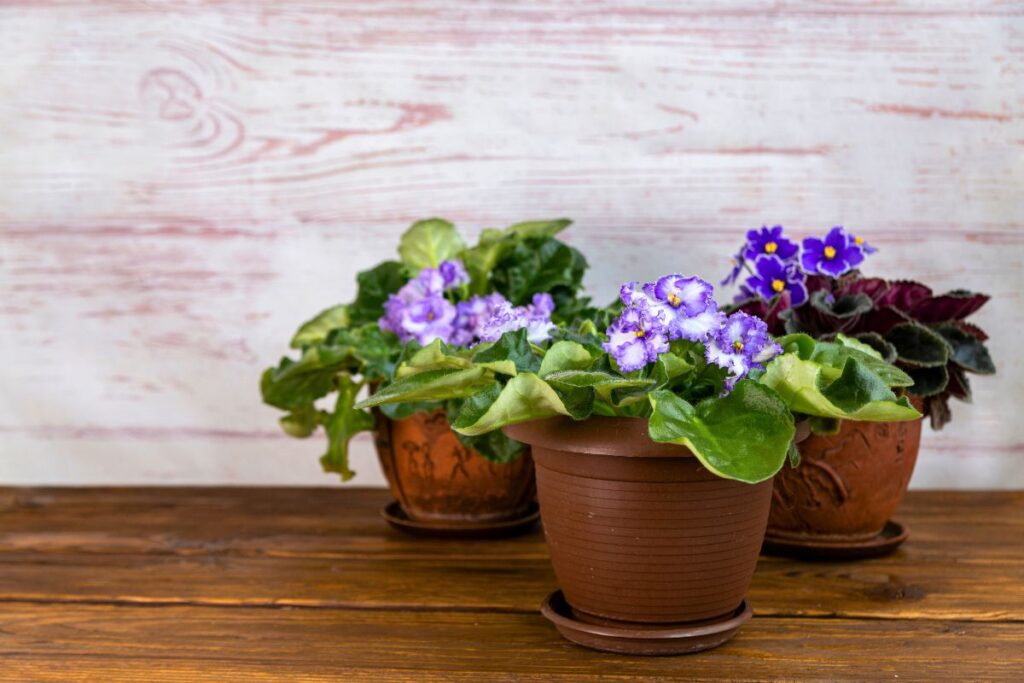African violets, with their vibrant flowers and fuzzy leaves, are a beloved choice for indoor gardeners. Known for their ability to bloom year-round, these charming plants can add a splash of color to any room. This comprehensive guide will provide you with everything you need to know about indoor care for African violets, ensuring they remain healthy and continue to produce beautiful blooms.

Contents
Understanding African Violets
African violets (Saintpaulia) are native to Tanzania and are part of the Gesneriaceae family. They are admired for their rosette-shaped growth and a wide range of flower colors, including purple, pink, white, and blue. African violets are compact plants, making them ideal for windowsills, tabletops, and small indoor spaces.
Light Requirements
African violets thrive in bright, indirect light. They require about 12-14 hours of light per day to bloom consistently. Place your African violets near a north or east-facing window where they can receive bright but filtered light. Avoid direct sunlight, as it can scorch their delicate leaves. If natural light is insufficient, you can use fluorescent grow lights or LED lights placed about 12-15 inches above the plants to provide the necessary light.
Watering Routine
Proper watering is crucial for the health of African violets. These plants prefer to be kept evenly moist but not soggy. Use room temperature water and avoid getting water on the leaves, as this can cause leaf spots and rot. Water your African violets from the bottom by placing the pot in a shallow tray of water for about 20-30 minutes, allowing the soil to absorb the water through the drainage holes. Remove the pot from the tray once the soil is adequately moist. Water your African violets when the top inch of soil feels dry to the touch.
Humidity and Temperature
African violets thrive in environments with moderate to high humidity, ideally around 50-60%. To maintain the necessary humidity levels, you can use a humidifier, place a tray of water near the plants, or group several plants together to create a microenvironment. Avoid placing your African violets near drafts, air conditioners, or heaters, as sudden temperature changes can stress the plants.
African violets prefer temperatures between 65-75°F (18-24°C). They are sensitive to cold drafts and temperatures below 60°F (15°C), which can hinder their growth and flowering.
Soil and Fertilization
African violets require a well-draining, lightweight soil mix. A commercial African violet potting mix is ideal, or you can create your own mix using equal parts peat moss, perlite, and vermiculite. This combination provides good aeration and prevents waterlogging.
Fertilize your African violets with a balanced, water-soluble fertilizer specifically formulated for African violets. Fertilize every 4-6 weeks during the growing season (spring and summer) to promote healthy growth and abundant blooms. Avoid over-fertilizing, as this can lead to leaf burn and reduced flowering.
Pruning and Grooming
Regular grooming helps maintain the health and appearance of African violets. Remove any dead or yellowing leaves and spent flowers to encourage new growth and prevent disease. Gently pinch off the leaves and flowers at the base of the plant. African violets benefit from occasional grooming to maintain their rosette shape and overall vitality.
Propagation
African violets are relatively easy to propagate from leaf cuttings. Follow these steps to propagate your African violets:
- Select a healthy leaf from the plant and cut it with a clean, sharp pair of scissors or pruning shears, leaving about 1-2 inches of the petiole (leaf stem).
- Dip the cut end of the petiole in rooting hormone to encourage root growth (optional).
- Insert the petiole into a small pot filled with a well-draining soil mix or a mix of peat moss and perlite.
- Water the soil lightly and cover the pot with a plastic bag or a clear dome to create a humid environment.
- Place the pot in a warm, bright location with indirect light.
- After a few weeks, roots and small plantlets will start to develop at the base of the leaf.
Once the new plantlets are established and have a few leaves, you can transplant them into individual pots and care for them as you would mature African violets.
Common Problems and Solutions
Leaf Spots
Leaf spots can occur when water sits on the leaves or if the plant is exposed to cold drafts. To prevent leaf spots, avoid overhead watering and ensure your African violets are in a stable, warm environment. If leaf spots appear, remove the affected leaves and adjust your watering routine.
Lack of Blooms
If your African violets are not blooming, they may not be receiving enough light or nutrients. Ensure your plants are placed in a bright location with indirect light and fertilize them regularly with a balanced fertilizer. Additionally, check for signs of pests or disease that may be hindering their growth.
Pests
Common pests that affect African violets include aphids, thrips, and mealybugs. Regularly inspect your plants and treat any infestations with insecticidal soap or neem oil. Isolate affected plants to prevent the pests from spreading to other houseplants.
Conclusion
African violets are a delightful addition to any indoor garden, offering vibrant blooms and charming foliage. By providing the right light, water, humidity, and care, you can ensure your African violets thrive and continue to produce beautiful flowers. With a bit of attention and patience, you’ll be rewarded with stunning and colorful African violets that will brighten your home all year round.
